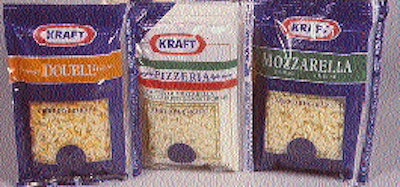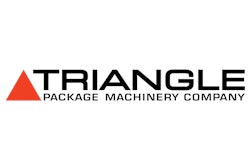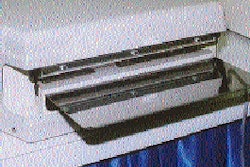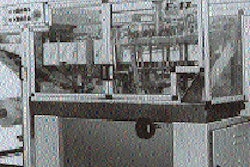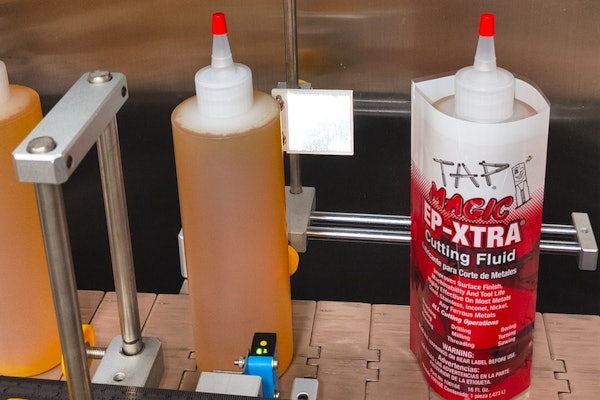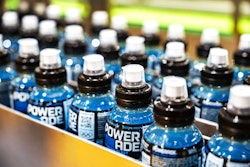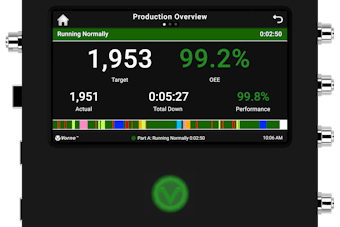The Ingleside, Ontario, facility of Kraft Canada, Inc. has been packaging grated cheese in flexible packages with zipper reclosures since the late '80s. Throughout that period, teams of Kraft employees have probed, pinched and prodded the packs to make them better in any way possible. Their efforts have now paid off handsomely: The zippered package exhibits better seal integrity than Kraft had even before it added the zipper.
In its earliest version of a zippered cheese package, Kraft Canada, like most packagers implementing zippers at the time, relied on rollstock that had the zipper profile preapplied. But by August of 1993, suppliers of flexible films and zipper profiles had begun to offer systems that allowed packagers to attach the zipper profile in-line. A Kraft Canada cross-functional team responsible for the shredded cheese package believed such systems had the potential for reduced downtime and lower material costs, so they decided to switch out of preapplied zipper profiles and apply them on line.
The retrofit kit they selected was supplied by Presto Products (Appleton, WI). It was mounted on a Triangle (Chicago, IL) vertical form/fill/seal system in the Ingleside facility, and before long zipper application was an on-line affair. But that didn't keep the members of Kraft's Continuous Improvement Teams from their appointed rounds, and no sooner was the retrofit in place than they began to study ways to improve its performance.
Specifically they wanted to reduce leakers. Initially they thought that the film structure was the cause of the leaker problem. But soon they learned that most of the problem was caused by excess zipper material at the cross seals. So in late '93 they asked Presto for a zipper profile 33% lighter than the one they'd begun with. The modified zipper also has a slightly reshaped female side that mates more effectively and securely with the male side. The new and improved profile is now available as a standard zipper style offered by Presto.
Modified retrofit
Also modified was the Presto retrofit equipment. A larger punch was tested to remove excess zipper material from the seal area. This helped reduce the level of heat and pressure required to create the seal at the zipper, equalizing the energy required to create the seal all the way across the package. By bringing this into balance, Kraft was able to avoid leaks that are sometimes caused when the nonzipper seal areas become overheated.
A final modification was in the zipper's sealant layer, coextruded by Presto to be compatible with Kraft's existing film structure. This is a low-density polyethylene with a percentage of ethylene vinyl acetate. Its EVA content was raised slightly to improve adhesion to the pouch material.
Presto's system includes two unwinds, one for the zipper and one for the tear string. A tension-controlled feed system within the unwind ensures that the zipper and tear string are fed consistently with the web's intermittent advance. In addition, Presto's zipper roll holds as much as 14ꯠ' of material, minimizing changeovers.
A tear string sealer located within the vf/f/s machine heat seals the string to the film as the web unwinds. As the zipper enters the machine, it runs through the punch that eliminates bulk from the zipper at the point where it will be cross-sealed. The zipper is then fed in along the side of the fill tube and meets up with the film below the forming collar, in the area of the fin sealer. A zipper guide added to a conventional forming collar and fill tube assembly positions the interlocking Fresh-Trak® zipper as it is heat sealed to the film. Finally, the cross seals are created, product is dispensed through the fill tube and the reclosable package is complete.
The modified system has been in use now since February '94. The Continuous Improvement Teams involved in improving package seals were presented with Quality Achievement Awards at a recent Kraft Canada annual awards banquet.
"Presto was extremely helpful in assisting our quality efforts on this project," says packaging technician Dane St. Pierre.
